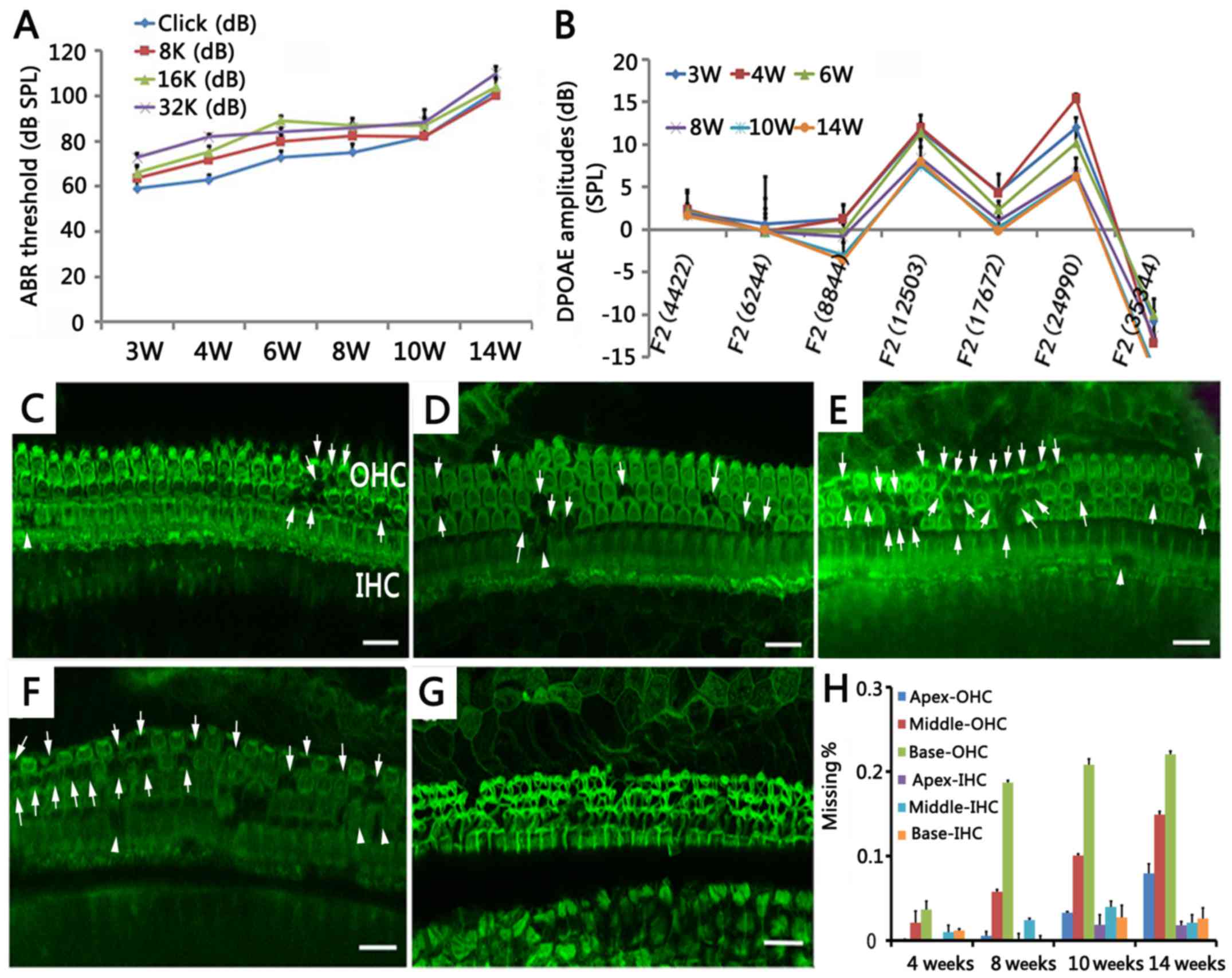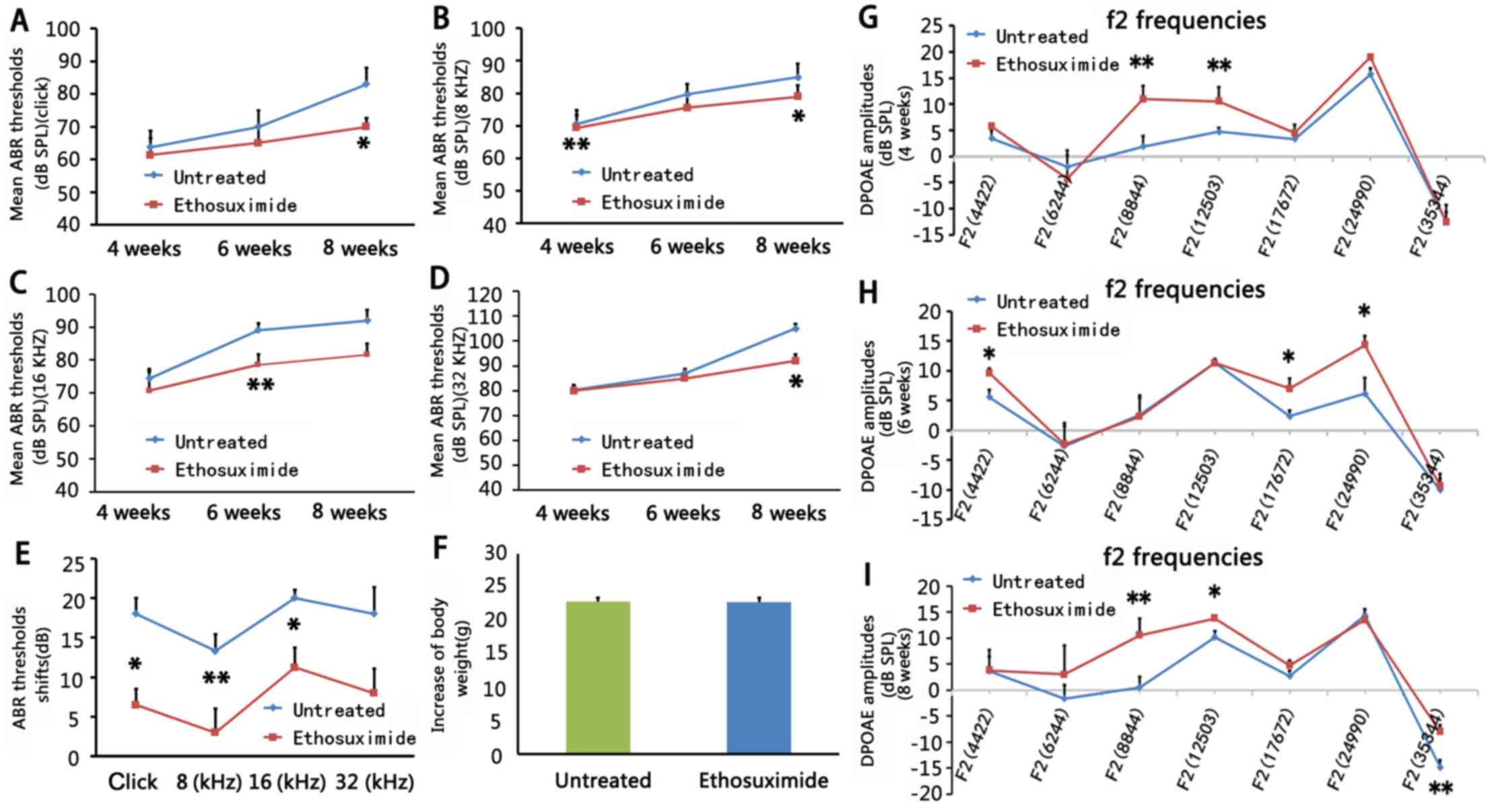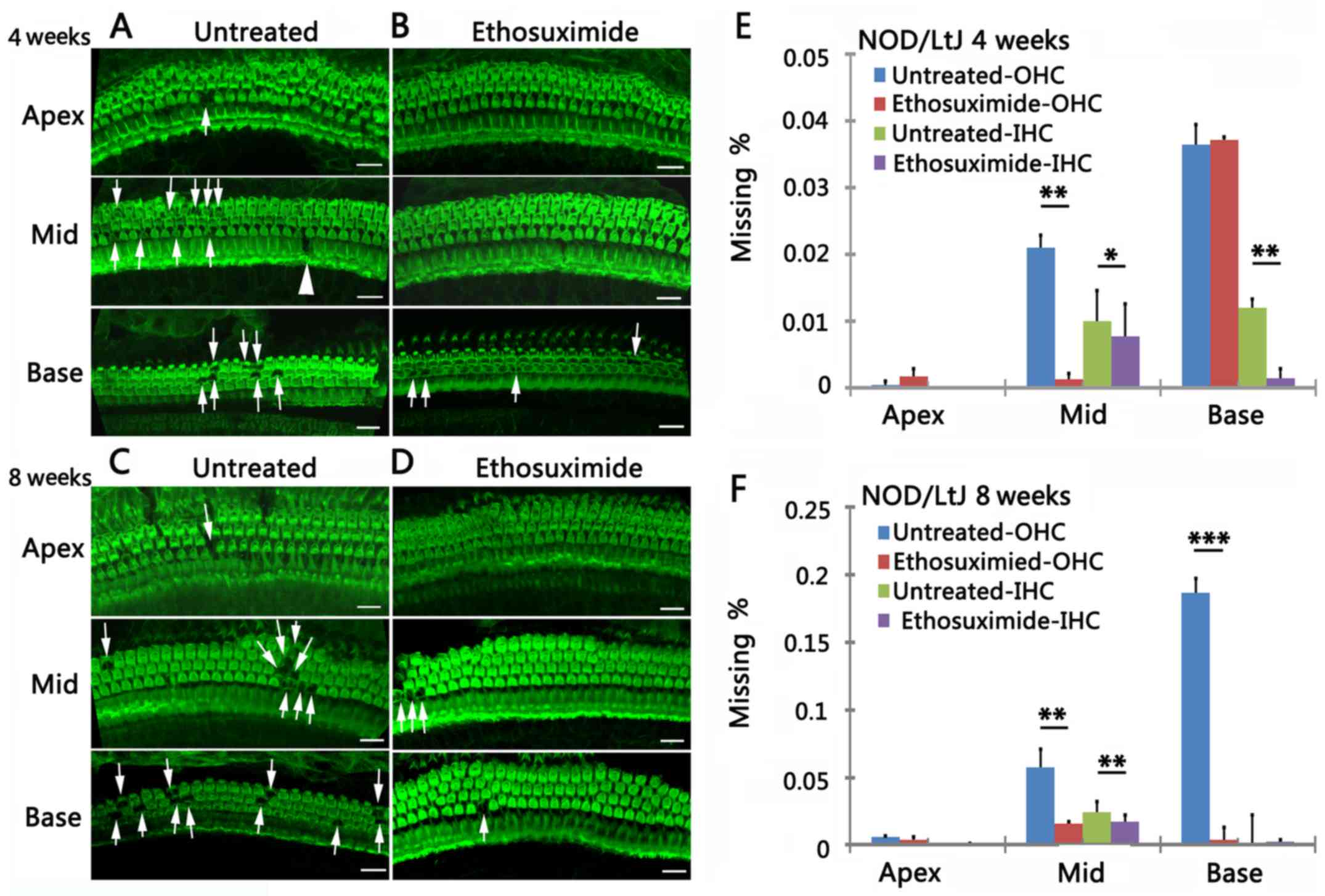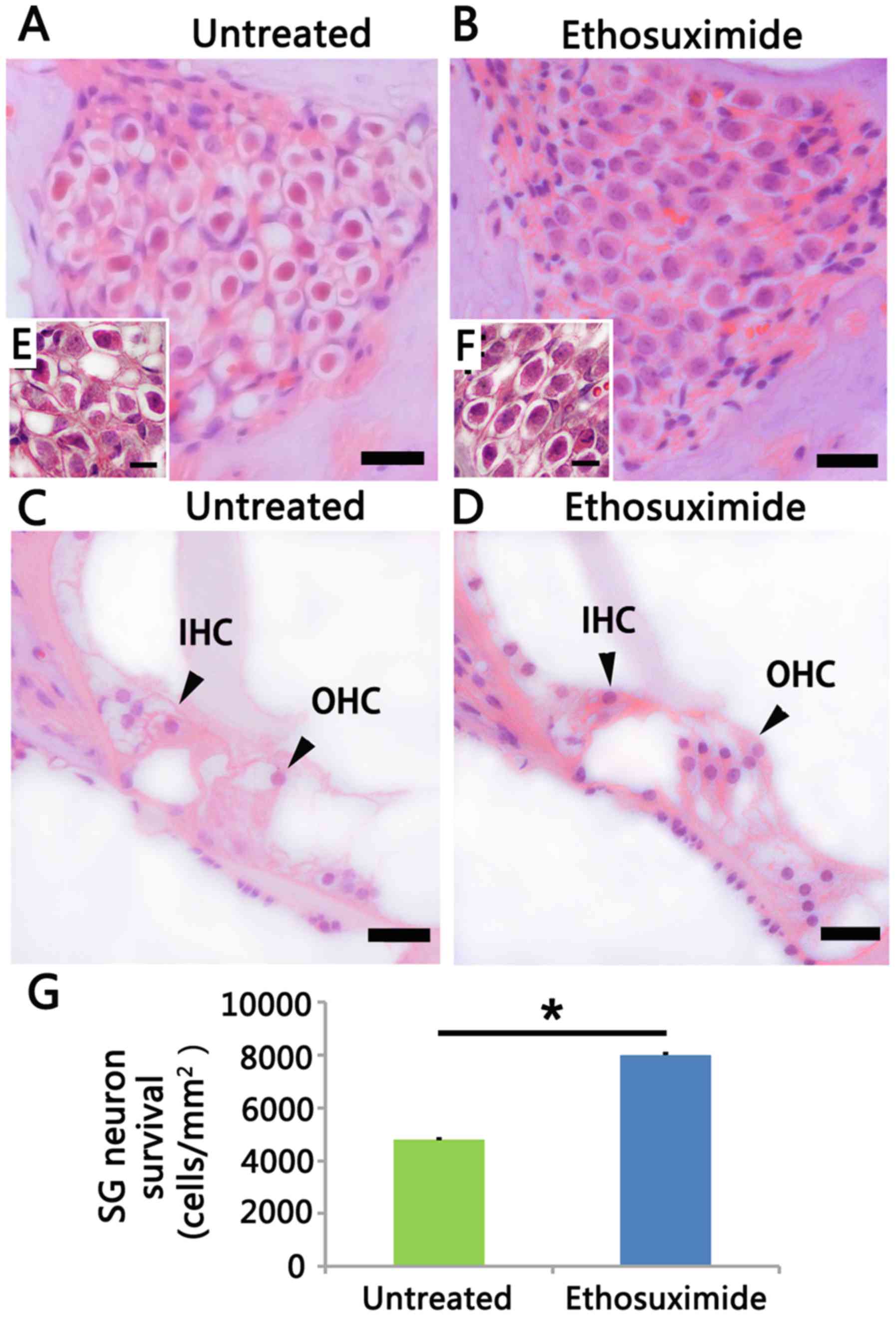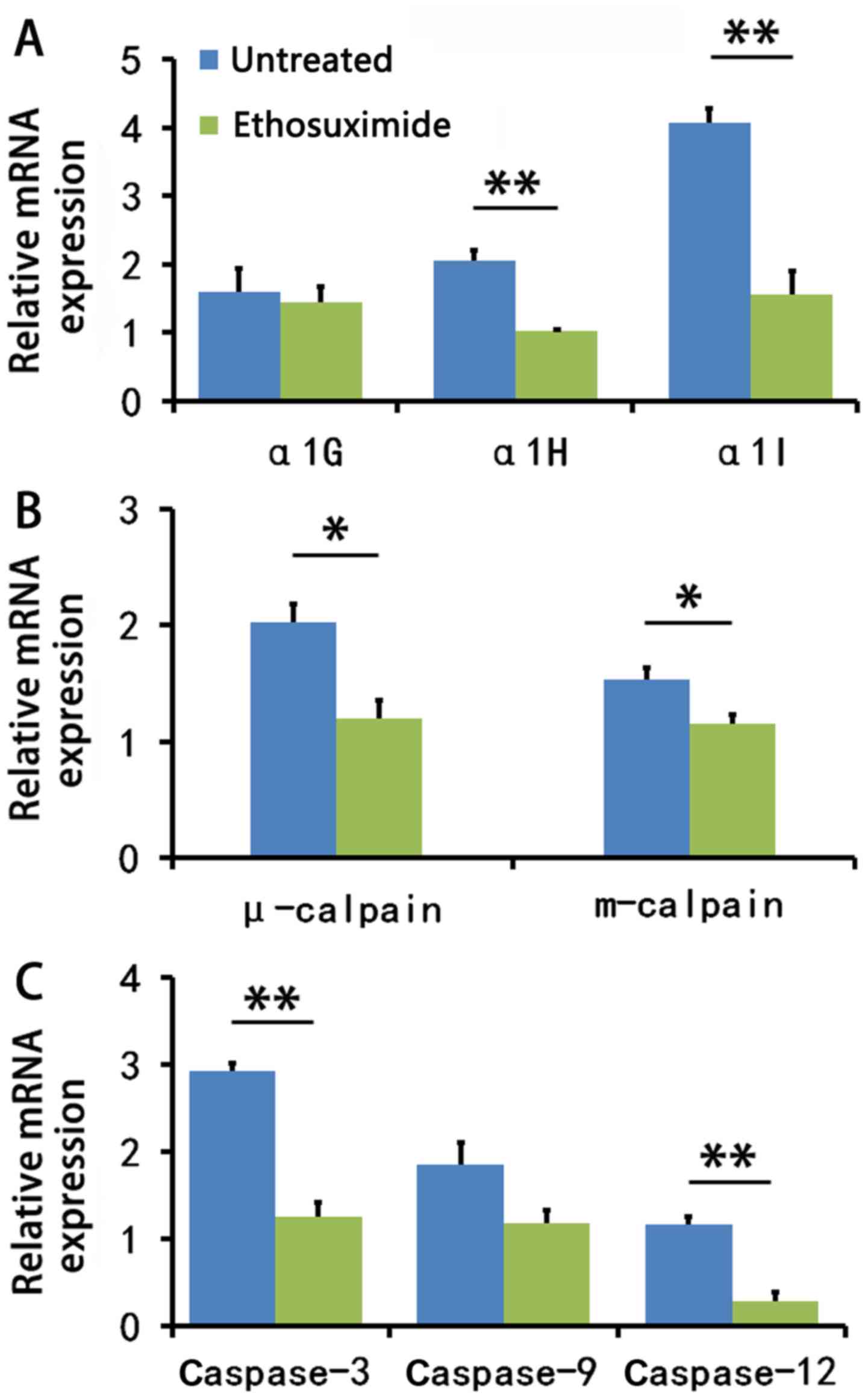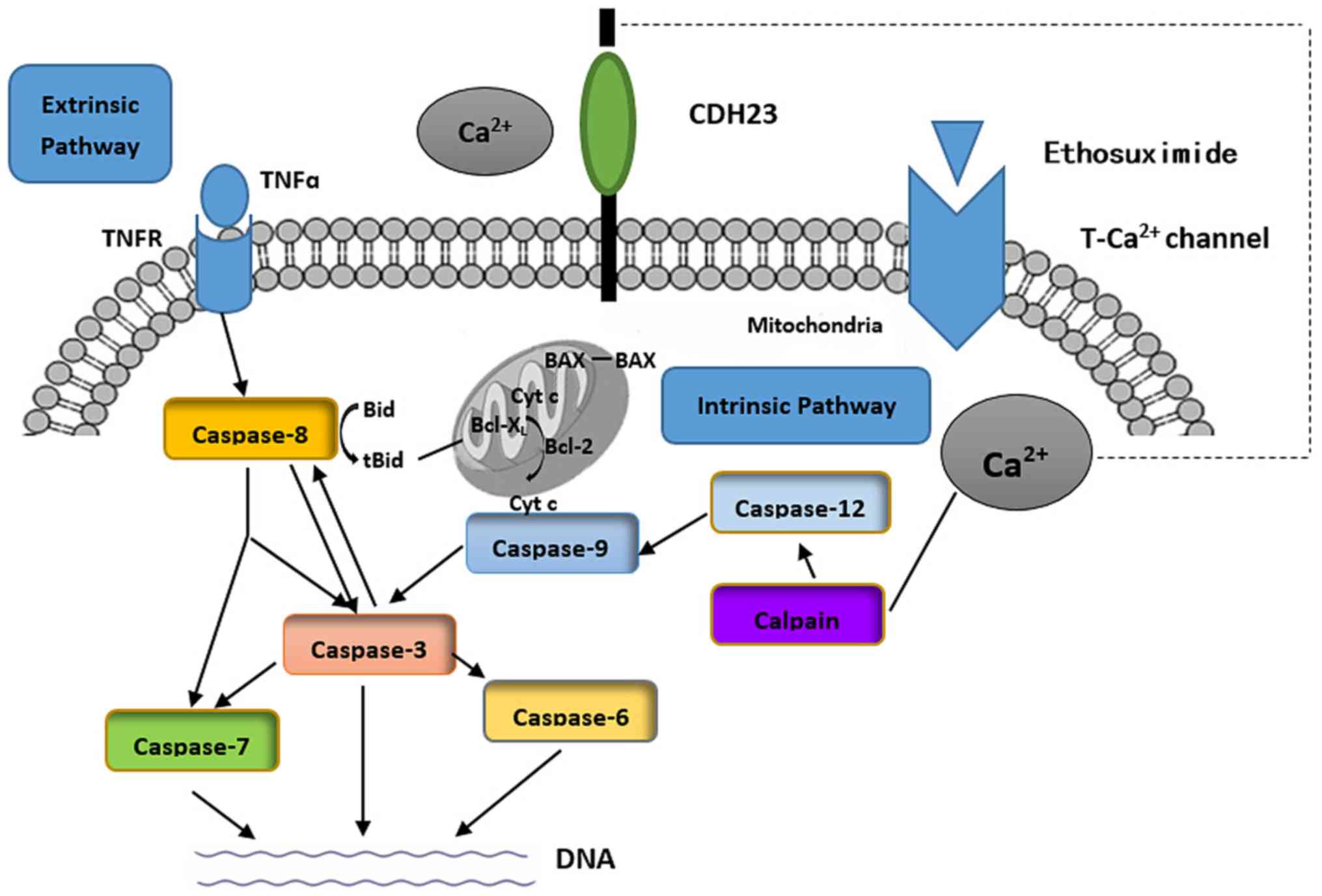|
1
|
Gorlin RJ, Toriello HV and Cohen M:
Hereditary Hearing Loss and Its Syndrome. Oxford University Press;
1995
|
|
2
|
Morton NE: Genetic epidemiology of hearing
impairment. Ann NY Acad Sci. 630:16–31. 1991. View Article : Google Scholar : PubMed/NCBI
|
|
3
|
Mulrow CD, Aguilar C, Endicott JE, Velez
R, Tuley MR, Charlip WS, Hill Mulrow CD, Aguilar C, Endicott JE,
Velez R, Tuley MR, Charlip WS and Hill JA: JA: Association between
hearing impairment and the quality of life of elderly individuals.
J Am Geriatr Soc. 38:45–50. 1990. View Article : Google Scholar : PubMed/NCBI
|
|
4
|
Lin FR, Niparko JK and Ferrucci L: Hearing
loss prevalence in the United States. Arch Intern Med.
171:1851–1852. 2001. View Article : Google Scholar
|
|
5
|
Appler JM and Goodrich LV: Connecting the
ear to the brain: Molecular mechanisms of auditory circuit
assembly. Prog Neurobiol. 93:488–508. 2011. View Article : Google Scholar : PubMed/NCBI
|
|
6
|
Johnson KR and Zheng QY: Ahl2, a second
locus affecting age-related hearing loss in mice. Genomics.
80:461–464. 2002. View Article : Google Scholar : PubMed/NCBI
|
|
7
|
Noben-Trauth K, Zheng QY and Johnson KR:
Association of cadherin 23 with polygenic inheritance and genetic
modification of sensorineural hearing loss. Nat Genet. 35:21–23.
2003. View
Article : Google Scholar : PubMed/NCBI
|
|
8
|
Mills JH, Matthews LJ, Lee FS, Dubno JR,
Schulte BA and Weber PC: Gender-specific effects of drugs on
hearing levels of older persons. Ann NY Acad Sci. 884:381–388.
1999. View Article : Google Scholar
|
|
9
|
Youle RJ and Strasser A: The BCL-2 protein
family: Opposing activities that mediate cell death. Nat Rev Mol
Cell Biol. 9:47–59. 2008. View
Article : Google Scholar
|
|
10
|
Someya S, Yamasoba T, Weindruch R, Prolla
TA and Tanokura M: Caloric restriction suppresses apoptotic cell
death in the mammalian cochlea and leads to prevention of
presbycusis. Neurobiol Aging. 28:1613–1622. 2007. View Article : Google Scholar
|
|
11
|
Someya S, Yamasoba T, Kujoth GC, Pugh TD,
Weindruch R, Tanokura M and Prolla TA: The role of mtDNA mutations
in the pathogenesis of age-related hearing loss in mice carrying a
mutator DNA polymerase gamma. Neurobiol Aging. 29:1080–1092. 2008.
View Article : Google Scholar
|
|
12
|
Rogawski MA and Löscher W: The
neurobiology of antiepileptic drugs for the treatment of
nonepileptic conditions. Nat Med. 10:685–692. 2004. View Article : Google Scholar : PubMed/NCBI
|
|
13
|
Han F, Yu H, Tian C, Chen HE,
Benedict-Alderfer C, Zheng Y, Wang Q, Han X and Zheng QY: A new
mouse mutant of the Cdh23 gene with early-onset hearing loss
facilitates evaluation of otoprotection drugs. Pharmacogenomics J.
12:30–44. 2012. View Article : Google Scholar
|
|
14
|
Kusakawa G, Saito T, Onuki R, Ishiguro K,
Kishimoto T and Hisanaga S: Calpain-dependent proteolytic cleavage
of the p35 cyclin-dependent kinase 5 activator to p25. J Biol Chem.
275:17166–17172. 2000. View Article : Google Scholar : PubMed/NCBI
|
|
15
|
Nakagawa T and Yuan J: Cross-talk between
two cysteine protease families. Activation of caspase-12 by calpain
in apoptosis. J Cell Biol. 150:887–894. 2000. View Article : Google Scholar : PubMed/NCBI
|
|
16
|
Han F, Yu H, Zheng T, Ma X, Zhao X, Li P,
Le L, Su Y and Zheng QY: Otoprotective effects of erythropoietin on
Cdh23erl/erl mice. Neuroscience. 237:1–6. 2013.
View Article : Google Scholar : PubMed/NCBI
|
|
17
|
Johnson KR, Erway LC, Cook SA, Willott JF
and Zheng QY: A major gene affecting age-related hearing loss in
C57BL/6J mice. Hear Res. 114:83–92. 1997. View Article : Google Scholar
|
|
18
|
Zheng QY, Johnson KR and Erway LC:
Assessment of hearing in 80 inbred strains of mice by ABR threshold
analyses. Hear Res. 130:94–107. 1999. View Article : Google Scholar : PubMed/NCBI
|
|
19
|
Polak M, Eshraghi AA, Nehme O, Ahsan S,
Guzman J, Delgado RE, He J, Telischi FF, Balkany TJ and Van De
Water TR: Evaluation of hearing and auditory nerve function by
combining ABR, DPOAE and eABR tests into a single recording
session. J Neurosci Methods. 134:141–149. 2004. View Article : Google Scholar : PubMed/NCBI
|
|
20
|
Livak KJ and Schmittgen TD: Analysis of
relative gene expression data using real-time quantitative PCR and
the 2(−ΔΔC(T)) method. Methods. 25:402–408. 2001. View Article : Google Scholar
|
|
21
|
Perez-Reyes E, Cribbs LL, Daud A, Lacerda
AE, Barclay J, Williamson MP, Fox M, Rees M and Lee JH: Molecular
characterization of a neuronal low-voltage-activated T-type calcium
channel. Nature. 391:896–900. 1998. View
Article : Google Scholar : PubMed/NCBI
|
|
22
|
Creagh EM, Conroy H and Martin SJ:
Caspase-activation pathways in apoptosis and immunity. Immunol Rev.
193:10–21. 2003. View Article : Google Scholar : PubMed/NCBI
|
|
23
|
Yin XM: Signal transduction mediated by
Bid, a pro-death Bcl-2 family proteins, connects the death receptor
and mitochondria apoptosis pathways. Cell Res. 10:161–167. 2000.
View Article : Google Scholar : PubMed/NCBI
|
|
24
|
Azam M, Andrabi SS, Sahr KE, Kamath L,
Kuliopulos A and Chishti AH: Disruption of the mouse mu-calpain
gene reveals an essential role in platelet function. Mol Cell Biol.
21:2213–2220. 2001. View Article : Google Scholar : PubMed/NCBI
|
|
25
|
Schuknecht HF and Gacek MR: Cochlear
pathology in presbycusis. Ann Otol Rhinol Laryngol. 102:1–16. 1993.
View Article : Google Scholar : PubMed/NCBI
|
|
26
|
Keithley EM, Canto C, Zheng QY,
Fischel-Ghodsian N and Johnson KR: Age-related hearing loss and the
ahl locus in mice. Hear Res. 188:21–28. 2004. View Article : Google Scholar : PubMed/NCBI
|
|
27
|
Hudspeth AJ: How hearing happens. Neuron.
19:947–950. 1997. View Article : Google Scholar : PubMed/NCBI
|
|
28
|
Ehret G: Quantitative analysis of nerve
fibre densities in the cochlea of the house mouse (Mus musculus). J
Comp Neurol. 183:73–88. 1979. View Article : Google Scholar : PubMed/NCBI
|
|
29
|
Di Palma F, Pellegrino R and Noben-Trauth
K: Genomic structure, alternative splice forms and normal and
mutant alleles of cadherin 23 (Cdh23). Gene. 281:31–41. 2001.
View Article : Google Scholar : PubMed/NCBI
|
|
30
|
Di Palma F, Holme RH, Bryda EC,
Belyantseva IA, Pellegrino R, Kachar B, Steel KP and Noben-Trauth
K: Mutations in Cdh23, encoding a new type of cadherin, cause
stereocilia disorganization in waltzer, the mouse model for Usher
syndrome type 1D. Nat Genet. 27:103–107. 2001. View Article : Google Scholar : PubMed/NCBI
|
|
31
|
Siemens J, Lillo C, Dumont RA, Reynolds A,
Williams DS, Gillespie PG and Müller U: Cadherin 23 is a component
of the tip link in hair-cell stereocilia. Nature. 428:950–955.
2004. View Article : Google Scholar : PubMed/NCBI
|
|
32
|
Howard J and Hudspeth AJ: Compliance of
the hair bundle associated with gating of mechanoelectrical
transduction channels in the bullfrog's saccular hair cell. Neuron.
1:189–199. 1988. View Article : Google Scholar : PubMed/NCBI
|
|
33
|
Jia S, Dallos P and He DZ: Mechanoelectric
transduction of adult inner hair cells. J Neurosci. 27:1006–1014.
2007. View Article : Google Scholar : PubMed/NCBI
|
|
34
|
Chan DK, Lieberman DM, Musatov S, Goldfein
JA, Selesnick SH and Kaplitt MG: Protection against
cisplatin-induced ototoxicity by adeno-associated virus-mediated
delivery of the X-linked inhibitor of apoptosis protein is not
dependent on caspase inhibition. Otol Neurotol. 28:417–425. 2007.
View Article : Google Scholar : PubMed/NCBI
|
|
35
|
Lee S, Briklin O, Hiel H and Fuchs P:
Calcium-dependent inactivation of calcium channels in cochlear hair
cells of the chicken. J Physiol. 583:909–922. 2007. View Article : Google Scholar : PubMed/NCBI
|
|
36
|
Lopez I, Ishiyama G, Acuna D, Ishiyama A
and Baloh RW: Immunolocalization of voltage-gated calcium channel
alpha1 subunits in the chinchilla cochlea. Cell Tissue Res.
313:177–186. 2003. View Article : Google Scholar : PubMed/NCBI
|
|
37
|
Nie L, Zhu J, Gratton MA, Liao A, Mu KJ,
Nonner W, Richardson GP and Yamoah EN: Molecular identity and
functional properties of a novel T-type Ca2+ channel
cloned from the sensory epithelia of the mouse inner ear. J
Neurophysiol. 100:2287–2299. 2008. View Article : Google Scholar : PubMed/NCBI
|
|
38
|
Shen H, Zhang B, Shin JH, Lei D, Du Y, Gao
X, Wang Q, Ohlemiller KK, Piccirillo J and Bao J: Prophylactic and
therapeutic functions of T-type calcium blockers against
noise-induced hearing loss. Hear Res. 226:52–60. 2007. View Article : Google Scholar : PubMed/NCBI
|
|
39
|
Becker AJ, Pitsch J, Sochivko D, Opitz T,
Staniek M, Chen CC, Campbell KP, Schoch S, Yaari Y and Beck H:
Transcriptional upregulation of Cav3.2 mediates epileptogenesis in
the pilocarpine model of epilepsy. J Neurosci. 28:13341–13353.
2008. View Article : Google Scholar : PubMed/NCBI
|
|
40
|
Deshpande LS, Limbrick DD Jr, Sombati S
and DeLorenzo RJ: Activation of a novel injury-induced
calcium-permeable channel that plays a key role in causing extended
neuronal depolarization and initiating neuronal death in
excitotoxic neuronal injury. J Pharmacol Exp Ther. 322:443–452.
2007. View Article : Google Scholar : PubMed/NCBI
|
|
41
|
Matsunami M, Kirishi S, Okui T and
Kawabata A: Hydrogen sulfide-induced colonic mucosal cytoprotection
involves T-type calcium channel-dependent neuronal excitation in
rats. J Physiol Pharmacol. 63:61–68. 2012.PubMed/NCBI
|
|
42
|
Lei D, Gao X, Perez P, Ohlemiller KK, Chen
CC, Campbell KP, Hood AY and Bao J: Anti-epileptic drugs delay
age-related loss of spiral ganglion neurons via T-type calcium
channel. Hear Res. 278:106–112. 2011. View Article : Google Scholar : PubMed/NCBI
|
|
43
|
Gao M, Wong SY, Lau PM and Kong SK:
Ferutinin induces in vitro eryptosis/erythroptosis in human
erythrocytes through membrane permeabilization and calcium influx.
Chem Res Toxicol. 26:1218–1228. 2013. View Article : Google Scholar : PubMed/NCBI
|
|
44
|
Ding D, Stracher A and Salvi RJ: Leupeptin
protects cochlear and vestibular hair cells from gentamicin
ototoxicity. Hear Res. 164:115–126. 2002. View Article : Google Scholar : PubMed/NCBI
|
|
45
|
Coulter DA, Sombati S and DeLorenzo RJ:
Electrophysiology of glutamate neurotoxicity in vitro: Induction of
a calcium-dependent extended neuronal depolarization. J
Neurophysiol. 68:362–373. 1992.PubMed/NCBI
|
|
46
|
Limbrick DD Jr, Pal S and DeLorenzo RJ:
Hippocampal neurons exhibit both persistent Ca2+ influx
and impairment of Ca2+ sequestration/extrusion
mechanisms following excitotoxic glutamate exposure. Brain Res.
894:56–67. 2001. View Article : Google Scholar : PubMed/NCBI
|















